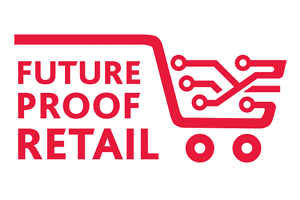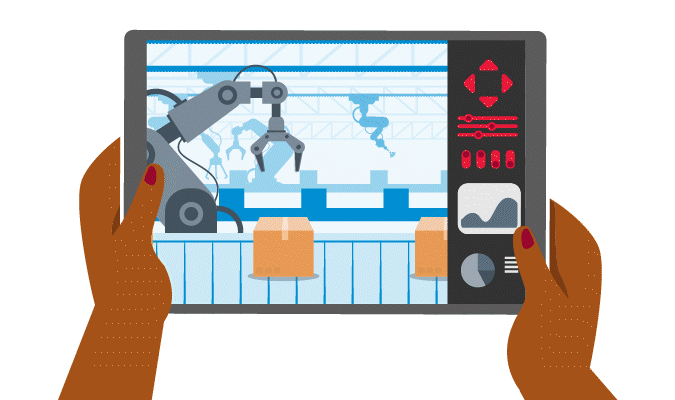Next Generation Fulfillment Centers

From Manual to Machine: How Advanced Fulfillment Centers Transform Jobs
The year is 2028. You work in a major retailer’s fulfillment center. It’s an extremely fast-paced workplace, with thousands of packages making their way through it over the course of a single day. You’ve spent most of your career in this building — sorting shipments, packing inventory, chasing down misplaced merchandise — and you know it inside and out.
One day, your employer announces plans to roll out a fulfillment center upgrade across its network. The upgrades will bring a wide slate of improvements to the warehouse, like robotic arms for picking products, or artificial intelligence (AI) powered conveyors that know exactly what they’re transporting and where it needs to go. The announcement is filled with buzzy phrases like greater efficiencies, improved cost management, and data-powered operations. But you’re left wondering about what it doesn’t discuss: How these changes will impact your role. What will it be like to work with all this automation? You don’t have a technical background, so how will you keep up?
Then, to your surprise, your supervisor calls you in to discuss the upcoming changes. He offers you a spot in a new upskilling program, where you’ll be trained to work alongside the new advanced machinery. You agree right away, relieved to know what’s next — and excited for a new chapter in your career.

By the time 2036 rolls around, you’re back on the fulfillment center floor, and so much has changed. Aerial drones hover from place to place up above, ferrying items. Meanwhile, the floor is filled with autonomous guided vehicles (AGVs), humming down newly designated lanes, carrying heavy boxes and large stacks of goods. Thanks to your new augmented reality (AR) headset, the once monochrome and dreary space is now awash with color. You see yellow caution ribbons around the AGV lanes, green condition updates from the radio frequency identification (RFID) tags embedded in each package, and blue pathfinding indicators from the aerial drones on your display. But you can’t stop and admire it for too long. A flashing red notification pings into view. Your presence is needed to resolve a weight distribution issue on one of the AGVs. No more heavy lifting and tedious manual sorting. Now you oversee these autonomous machines and can accomplish much more in a day than you could before.
Next generation fulfillment centers (NGFCs) are just over the horizon. In some cases, they’re already here — and they’re promising big gains. According to Retail Dive, one major retailer estimates that four of its NGFCs will be able to provide 75% of the U.S. population with one- or two-day shipping. These upgraded facilities will bring new advantages over the traditional model: advanced tracking and sorting technologies, improved scalability, and higher customer satisfaction thanks to more streamlined and efficient processes. As more retailers elect to future proof their businesses, NGFCs will become the industry standard.
But these technology enhancements will also carry significant workforce implications, and retailers must be ready to contend with them.
With powerful new tools comes the need new skill sets. Want to empower your staff? Listen to BDO’s 60-second Retail Podcast episode: Is AR/VR the Key to Upskilling the Future Retail Workforce?
Automation Isn’t So Automatic
Retailers seeking to future proof their organizations should start planning for NGFCs today. But upgrading their technology is just one piece of the puzzle. NGFCs will demand new roles with more specialized skills, such as virtual reality (VR) and AR specialists, advanced machinery technicians, and data analysts. Many of these roles will require deep technical or customer service experience. This shift might not seem so big in the context of a single organization, but it has major implications as an industry shift — and it presents both risk and opportunity for retailers.
As demand for skilled workers grows, the already- competitive retail labor market will tighten further. Retailers could find themselves in bidding wars to draw in specialized employees who can work with troves of data, train AI, and upkeep advanced machinery. Even considering the costs saved by automation, retailers could wind up paying more for labor than they currently are if they rely solely on new hires to meet their needs. As NGFC adoption accelerates, retailers must prioritize human capital management in their future proofing plans.
NGFCs also mean physical changes to existing fulfillment centers. For instance, renovating or expanding a fulfillment center might not mean growing the square footage. It could mean expanding upward and adopting autonomous aerial drones that can work safely at heights that would be impractical for human workers. It could even mean reformatting existing spaces and packing shelves more densely to make the best use of precision tracking and picking tools.
In addition to these changes, AGVs, rather than manually operated forklifts, will have to navigate the floor space, further enhancing the efficiency and automation of the facility, but requiring additional space considerations as well.
These physical changes could bring new safety concerns for workers. Retailers will need to mitigate the risk of on-premises injuries with each new tool they introduce. Rolling out physical changes without proper trainings or safety measures is another way that NGFCs could bring on both reputational and monetary consequences. Automation-related injuries are already occurring in cases where workers are pressured to keep up with automations and sustain injuries caused by making repetitive, strenuous movements at an unsustainable rate.
The common thread? Retailers cannot afford to delay upgrading their fulfillment centers to keep pace with a rapidly changing landscape, but they must also update their policies and upskill their workforce while they do so. Being reactive, rather than proactive, could prevent retailers from realizing the full benefits of their NGFC and improving customer experience as a result — even if the technology itself is top- tier. A thorough change management plan can help retailers upgrade their workforce alongside their tech.
Want more details about how the warehouses and fulfillment centers of the future could look? Listen to BDO’s 60-second Retail Podcast episode: Transforming Operations with Ground Robotics.
New Tools, New You: Upgrading and Upskilling
Conversations around automation are likely to be met with some resistance. Retail leaders should engage with employees and meet uncertainty with clear communication, address skepticism with a concrete vision and well- defined objectives, and foster buy-in by placing training and development opportunities front and center. These pillars are fundamental to a robust change management plan.
The key to NGFC success, beyond the simple implementation of new technologies, will be finding the right balance between upskilling or reskilling, and bringing in new talent from outside the organization. Replacing an employee, or searching for and hiring a new one, can be expensive. Cultivating talent in-house is often more cost efficient, and doing so can insulate retailers from a tough labor market.
 Established growth opportunities will allow workers with experience and institutional knowledge to step up and continue supporting updates down the line. NGFCs are not a one-time enhancement and will continue to see improvements as technologies evolve and more tools become available. Investing in staff now will smooth the way for later rounds of future proofing, as they will be more able and willing to embrace changes when they arrive.
Established growth opportunities will allow workers with experience and institutional knowledge to step up and continue supporting updates down the line. NGFCs are not a one-time enhancement and will continue to see improvements as technologies evolve and more tools become available. Investing in staff now will smooth the way for later rounds of future proofing, as they will be more able and willing to embrace changes when they arrive.
Retailers should also apply this principle to space-related changes, which must include safety and usability considerations by design. The fulfillment centers of the future will feature humans working alongside an increasingly autonomous manual labor force, in addition to other complex technologies like AR and VR. A smaller, or more condensed, fulfillment center environment may seem beneficial for the bottom line, but it will only work if workers are still able to use it safely. For example, retailers should clearly delineate travel lanes for AGVs to avoid collisions. They should also open a dialogue with their employees to set goals and retool processes with the aim of avoiding burnout and maintaining a sustainable pace of work.
In a fulfillment center, everything is interconnected. A bottleneck in one place can delay operations in another, while improvements to one element function as improvements to the whole. NGFCs are no different. In building future proofing plans, it can be easy to get caught up in the excitement around smarter processes and flashy robotics, but the fulfillment center’s workforce is part of the same system. Retailers that want to take advantage of NGFCs must prepare ahead and implement a workforce management strategy in tandem with technological improvements.
Forward-thinking retailers likely already recognize the pressing need to upskill their employees. But even if they understand why upskilling matters, where and how to start can sometimes be the most difficult questions.
Future proofing the workforce demands creativity in hiring. To learn more about talent management today, read BDO’s insight: Addressing Manufacturing’s Workforce Crisis: Hiring Creatively to Build for the Future.
Building Your Next Generation Workforce: How BDO Can Help
BDO’s professionals bring deep industry experience to aid you in future proofing every aspect of your operation centers. BDO can work with you to address the “fear factor” inherent to change and approach change management in a way that helps satisfy employee concerns around career advancement or workplace safety.
We can help you ask the right questions to close knowledge gaps and inform a strategic workforce plan. Equipped with high-quality information, BDO can assist in creating training programs and a hiring strategy tailored to your organization’s needs. If you’re looking to update or change locations for your NGFCs, we can also help with site evaluation and related planning. In doing so, BDO enables retailers to effectively implement upgrades to their fulfillment centers to drive meaningful supply chain and customer experience improvements.
Ready to take your talent management strategy to new heights?
BDO’s Retail and Consumer Products professionals are available to offer powerful insights into fulfillment center and workforce transformation that can set your organization up for success now and into the future.